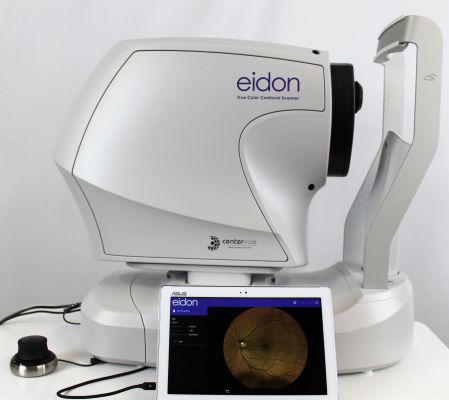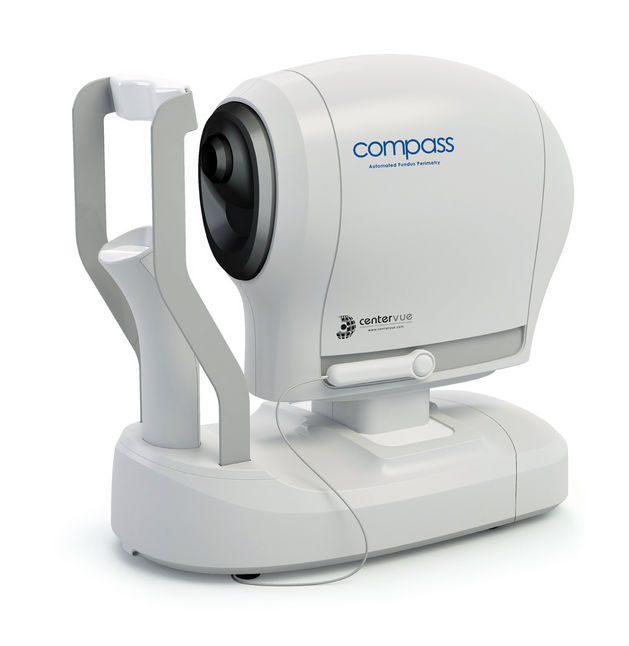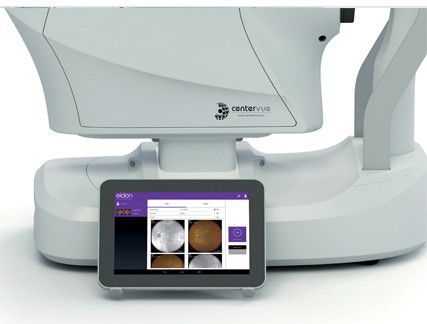Centervue Compass Non-mydriatic Fundus Camera is the new standard in perimetry. The Compass is a retina camera based on the very latest confocal LED scanning (SLO) technique.
Centervue Compass Combined with a 24-2 field of view, this instrument provides color real (True Color) images of the fundus combined with 24-2 standard Goldmann III field of view. And this entirely without the use of mydriatics.
Centervue Compass Non-mydriatic Fundus Camera microperimeter (CenterVue) has been designed to evaluate the fundamental 30º radius for glaucoma. Efforts to refine microperimetry for assessing glaucomatous visual areas should allow a greater functional assessment. Figure 2 presents an example of microperimetry employing the Compass device and also a Humphrey visual field 24-2 test routine.

Centervue Compass advantages:
- High-resolutionTrue Color confocal image of the ONH, RNFL and central retina
- Combined structure and function analysis
- Highly reliable tests and repeat tests thanks to the Retina Eye Tracking, which actively compensates eye movements, so that you always take the measurement at the same position.
- Reliably automated follow-up with combined structure-function progression analysis
- User-friendly: no trial lens required, by the automatic refractive correction
- More comfort for the patient: the test can be stopped at any time without loss of data
How Centervue Compass Works
Centervue Compass contributes to improving the accuracy of visual field tests. Thanks to its retinal tracker technology, the Centervue Compass automatically adjusts stimuli projection to current eye position and ensures the control of fixation losses.
The complete exam process includes alignment to the patient’s pupil, analysis of fixation and 24-2 VF test, in a fully automated way and without the need of refracting the patient. Its print out encompasses standard information derived from VF tests, combined with structural information derived from infrared and color.
Centervue Compass Key Features
– Pupillary tracking
– Fixation control using automated, high resolution, 25 Hz retinal tracking
– Auto-focus
– Fully automated, visual field testing (24-2, 10-2, custom)
– Confocal, 60°
– Color, red-free, and infrared images
– Analysis of Fixation
– Wired and WiFi network connectivity
– Touch-screen operated via tablet
– Non-mydriatic operation
Fundus Perimetry
- Projection field: 30° (radius)
- Background luminance: 31.4 asb
- Maximum luminance: 10000 asb
- Dynamic range: 0 – 50 dB
- Stimulus size: Goldmann III
- Stimulus duration: 200 ms
- Threshold tests: 24-2, 10-2
- Fixation control: 25 Hz automated retinal Tracking
- Foveal threshold testing
- Automatic pupil measurement
Fundus Imaging:
- Field of view: 60° (diameter)
- Sensor resolution: 5 Mpixel (2592×1944)
- Light source: infrared (825-870 nm) and white LED (440-650 nm)
- Imaging modalities: color, infrared, red-free
Centervue Compass key Features
- Automatic operation: auto-alignment, autofocus,
auto-retinal tracking, auto-pupil tracking,
auto-exposure, auto-capture - Non-mydriatic operation: minimum pupil size 3 mm
- Working distance: 28 mm
- Auto-focus range: -12D to +15D
- Fixation target:programmable, internal
- User interface: Nexus Tablet with 10.1” multitouch screen
- Connectivity: Wi-Fi and Ethernet
- Printer: Any printer compatible with Tablet
- Hard disk: SSD, 240 GB
Centervue Compass Dimensions:
- Weight: 25 Kg
- Size: H 620 X W 590 X D 360 mm
Electrical requirements:
- Power: 100-240 VAC, 50-60 Hz
- Consumption: 80 W

